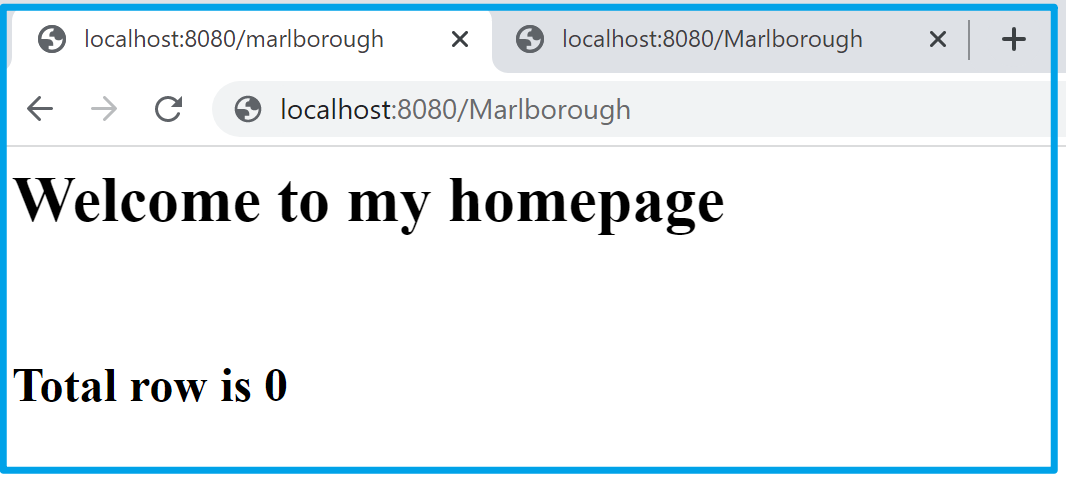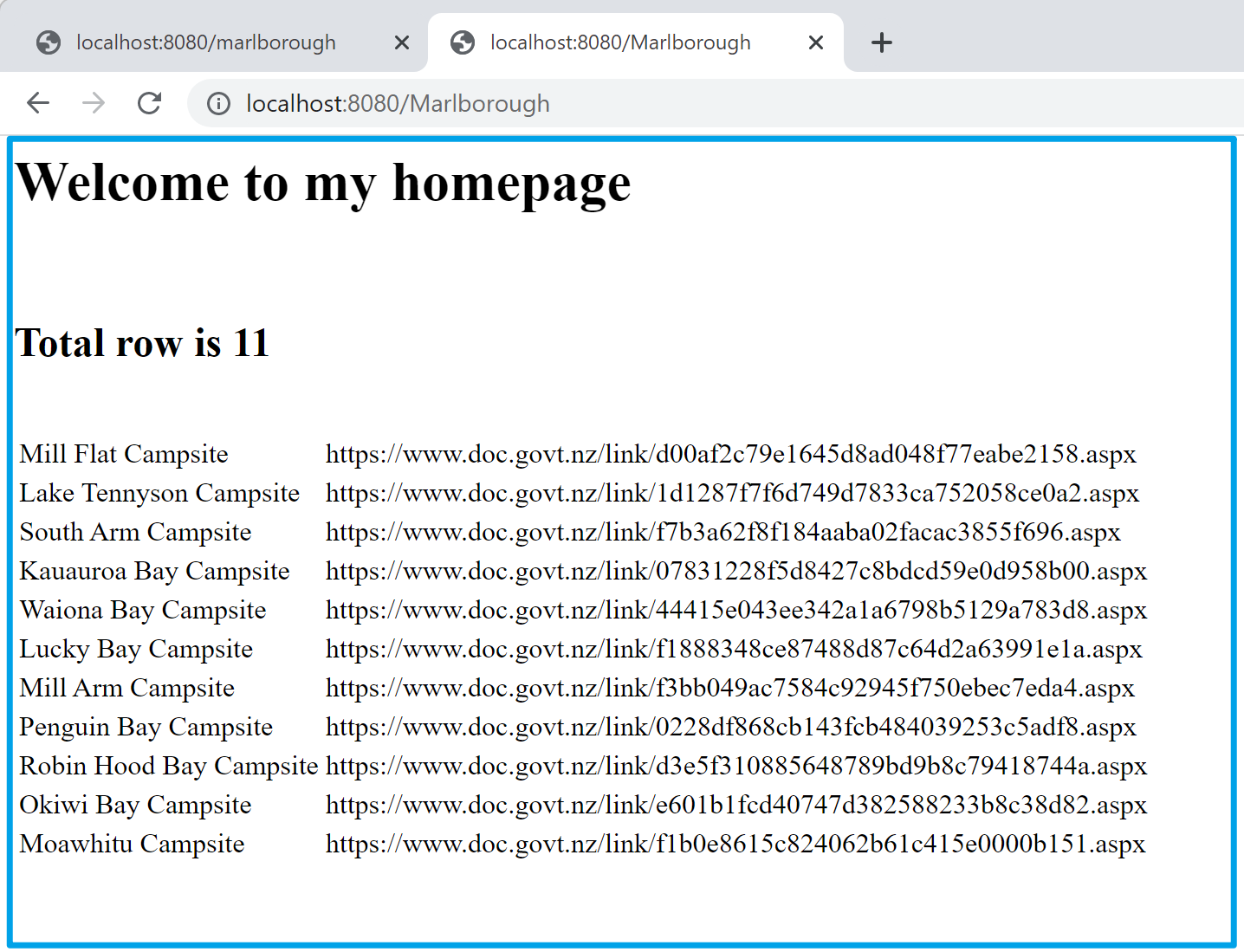【Azure Developer】Python 读取 json文件及过滤出需要的结果
问题描述
首先,有名为 campsites.json 的JSON数据文件,数据格式为
{
"type": "FeatureCollection",
"name": "DOC_Campsites",
"crs": { "type": "name", "properties": { "name": "urn:ogc:def:crs:OGC:1.3:CRS84" } },
"features": [
{
"type": "Feature",
"properties": {
"OBJECTID": 54996,
"name": "Rarangi Campsite",
"place": "Blenheim area",
"region": "Marlborough",
"introduction": "Camp next to the beach. Fish, walk, picnic, or simply sit and enjoy the roar of the waves.",
"campsiteCategory": "Standard",
"status": "OPEN",
"numberOfPoweredSites": 0,
"numberOfUnpoweredSites": 55,
"bookable": "No",
"free": null,
"facilities": "Water supply",
"activities": null,
"dogsAllowed": "Dogs with a DOC permit only",
"landscape": "Coastal",
"access": "Campervan, Car, Caravan",
"hasAlerts": "Refer to DOC website for current alerts",
"introductionThumbnail": "https://www.doc.govt.nz/thumbs/large/link/1b698c516b714b63b30de03203738e17.jpg",
"staticLink": "https://www.doc.govt.nz/link/f5c4e8776bee486aaa1ae8ebdc1e48f8.aspx",
"locationString": "Located in Blenheim area",
"x": 1687530,
"y": 5417097,
"assetId": 100030520,
"dateLoadedToGIS": "2021-05-28T04:15:08Z",
"GlobalID": "{C02F0A50-9316-459A-ADD9-93518E6677EA}"
},
"geometry": {"type": "Point","coordinates": [174.04700047400002,-41.39289982899993]}
}
, ... ...
]
}
全部的campsites.json文件内容下载地址:https://files.cnblogs.com/files/lulight/campsites.json?t=1655124060
修改下面的 server3.py 文件,以达到目标:当用户在浏览器中输入带有区域名称(例如 http://localhost:8080/Marlborough)的 URL 时,这个python服务器应该查询 region=Marlborough 的区域中的 Campsite category 类别为“Great Walk”的 Name + staticLink 数据在页面中
server3.py 文件内容:
#Author: Sunil Lal #This is a simple HTTP server which listens on port 8080, accepts connection request, and processes the client request
#in sepearte threads. It implements basic service functions (methods) which generate HTTP response to service the HTTP requests.
#Currently there are 3 service functions; default, welcome and getFile. The process function maps the requet URL pattern to the service function.
#When the requested resource in the URL is empty, the default function is called which currently invokes the welcome function.
#The welcome service function responds with a simple HTTP response: "Welcome to my homepage".
#The getFile service function fetches the requested html or img file and generates an HTTP response containing the file contents and appropriate headers. #To extend this server's functionality, define your service function(s), and map it to suitable URL pattern in the process function. #This web server runs on python v3
#Usage: execute this program, open your browser (preferably chrome) and type http://servername:8080
#e.g. if server.py and broswer are running on the same machine, then use http://localhost:8080 from socket import *
import _thread serverSocket = socket(AF_INET, SOCK_STREAM) serverPort = 8080
serverSocket.setsockopt(SOL_SOCKET, SO_REUSEADDR, 1)
serverSocket.bind(("", serverPort)) serverSocket.listen(5)
print('The server is running')
# Server should be up and running and listening to the incoming connections #Extract the given header value from the HTTP request message
def getHeader(message, header): if message.find(header) > -1:
value = message.split(header)[1].split()[0]
else:
value = None return value #service function to fetch the requested file, and send the contents back to the client in a HTTP response.
def getFile(filename): try: # open and read the file contents. This becomes the body of the HTTP response
f = open(filename, "rb") body = f.read() header = ("HTTP/1.1 200 OK\r\n\r\n").encode() except IOError: # Send HTTP response message for resource not found
header = "HTTP/1.1 404 Not Found\r\n\r\n".encode()
body = "<html><head></head><body><h1>404 Not Found</h1></body></html>\r\n".encode() return header, body #service function to generate HTTP response with a simple welcome message
def welcome(message): header = "HTTP/1.1 200 OK\r\n\r\n".encode()
body = ("<html><head></head><body><h1>Welcome to my homepage</h1></body></html>\r\n").encode() return header, body #default service function
def default(message): header, body = welcome(message) return header, body #We process client request here. The requested resource in the URL is mapped to a service function which generates the HTTP reponse
#that is eventually returned to the client.
def process(connectionSocket) :
# Receives the request message from the client
message = connectionSocket.recv(1024).decode() if len(message) > 1: # Extract the path of the requested object from the message
# Because the extracted path of the HTTP request includes
# a character '/', we read the path from the second character
resource = message.split()[1][1:] #map requested resource (contained in the URL) to specific function which generates HTTP response
if resource == "":
responseHeader, responseBody = default(message)
elif resource == "welcome":
responseHeader,responseBody = welcome(message)
else:
responseHeader,responseBody = getFile(resource) # Send the HTTP response header line to the connection socket
connectionSocket.send(responseHeader)
# Send the content of the HTTP body (e.g. requested file) to the connection socket
connectionSocket.send(responseBody)
# Close the client connection socket
connectionSocket.close() #Main web server loop. It simply accepts TCP connections, and get the request processed in seperate threads.
while True: # Set up a new connection from the client
connectionSocket, addr = serverSocket.accept()
#Clients timeout after 60 seconds of inactivity and must reconnect.
connectionSocket.settimeout(60)
# start new thread to handle incoming request
_thread.start_new_thread(process,(connectionSocket,))
问题解答
在server3.py 文件中,实现了默认Default,welcome 和 getFile 方法,当访问URL为 http://localhost:8080 时,调用default方法,输出 Welcome to my homepage 信息。同理,当访问URL为 http://localhost:8080/welcome 时,调用welcome方法,同样输出 Welcome to my homepage 信息。 而 getFile 方法,则是读取指定的文件,输出文件内容。所以,本题最重要的代码部分为 getFile方法实现。
当用户在浏览器中输入带有区域名称(例如 http://localhost:8080/Marlborough)的 URL 时,这个python服务器应该查询 region=Marlborough 的区域中的 Campsite category 类别为“Great Walk”的 Name + staticLink 数据在页面中
第一步:引入 JSON 包
import json
第二步:定义 region 和 campsiteCategory的过滤条件 condition1 和 condition2,以及指定filename为 campsites.json (因为这里只是完成题目,所以硬编码在代码中)
filename = "campsites.json"
condition1 = "Marlborough"
condition2 = "Basic" # "Great Walk"
第三步:开始使用Json.load文件中的数据,把内容转换为 dict对象,然后根据 JSON格式,读取 features 列表,通过for 循环来一条一条的判断 condtion1 和 condition 2,满足条件,通过html拼接为一个Table
def getFile(regionname):
try:
filename = "campsites.json"
condition1 = "Marlborough"
condition2 = "Basic" # "Great Walk"
# open and read the file contents. This becomes the body of the HTTP response
f = open(filename, "rb")
jdata = json.load(f)
# 查询region=Marlborough的区域中的Campsite category类别为“Great Walk”的Name , site总数并返回
# region=Marlborough
## campsiteCategory =="Great Walk";
# print(jdata['name']);
# print(jdata['features'][1]['properties']['region'])
# print(type(jdata['features'][1]))
outputTable = ""
index = 0
for fs in jdata['features']:
if fs['properties']['region'] == condition1 and fs['properties']['campsiteCategory'] == condition2:
outputTable += "<tr><td>" + \
fs['properties']['name']+"</td><td>" + \
fs['properties']['staticLink']+"</td></tr>"
# print(fs['properties']['campsiteCategory'])
index += 1
body = ("<html><head></head><body><h1>Welcome to my homepage</h1><br><h2>Total row is " +
str(index)+"</h2><br><table>"+outputTable+"</table></body></html>\r\n").encode()
header = ("HTTP/1.1 200 OK\r\n\r\n").encode()
except IOError:
# Send HTTP response message for resource not found
header = "HTTP/1.1 404 Not Found\r\n\r\n".encode()
body = "<html><head></head><body><h1>404 Not Found</h1></body></html>\r\n".encode()
return header, body
第四步:运行 python server3.py, 检验结果
> python server3.py

因为 campsites.json 数据源中,没有同时满足 region =="Marlborough" 和 campsiteCategory =="Great Walk" 的数据。
所以为了展示页面效果,修改了过滤条件为:
def getFile(regionname):
try:
filename = "campsites.json"
condition1 = regionname; # "Marlborough"
condition2 = "Basic" # "Great Walk"
再次测试的效果如下:

【END】
附录:完整的Server3.py 代码
# Author: Sunil Lal # This is a simple HTTP server which listens on port 8080, accepts connection request, and processes the client request
# in sepearte threads. It implements basic service functions (methods) which generate HTTP response to service the HTTP requests.
# Currently there are 3 service functions; default, welcome and getFile. The process function maps the requet URL pattern to the service function.
# When the requested resource in the URL is empty, the default function is called which currently invokes the welcome function.
# The welcome service function responds with a simple HTTP response: "Welcome to my homepage".
# The getFile service function fetches the requested html or img file and generates an HTTP response containing the file contents and appropriate headers. # To extend this server's functionality, define your service function(s), and map it to suitable URL pattern in the process function. # This web server runs on python v3
# Usage: execute this program, open your browser (preferably chrome) and type http://servername:8080
# e.g. if server.py and broswer are running on the same machine, then use http://localhost:8080 from socket import *
import _thread
import json serverSocket = socket(AF_INET, SOCK_STREAM) serverPort = 8080
serverSocket.setsockopt(SOL_SOCKET, SO_REUSEADDR, 1)
serverSocket.bind(("", serverPort)) serverSocket.listen(5)
print('The server is running')
# Server should be up and running and listening to the incoming connections # Extract the given header value from the HTTP request message def getHeader(message, header): if message.find(header) > -1:
value = message.split(header)[1].split()[0]
else:
value = None return value # service function to fetch the requested file, and send the contents back to the client in a HTTP response. def getFile(regionname): try:
filename = "campsites.json"
condition1 = regionname; # "Marlborough"
condition2 = "Basic" # "Great Walk"
# open and read the file contents. This becomes the body of the HTTP response
f = open(filename, "rb")
#body = f.read()
jdata = json.load(f) # 查询region=Marlborough的区域中的Campsite category类别为“Great Walk”的Name , site总数并返回
# region=Marlborough
## campsiteCategory =="Great Walk"; # print(jdata['name']);
# print(jdata['crs']);
# print(jdata['features'][1]['properties']['region'])
# print(jdata['features'][1]['properties']['campsiteCategory'])
# print(type(jdata['features'][1])) outputTable = ""
index = 0
for fs in jdata['features']:
if fs['properties']['region'] == condition1 and fs['properties']['campsiteCategory'] == condition2:
outputTable += "<tr><td>" + \
fs['properties']['name']+"</td><td>" + \
fs['properties']['staticLink']+"</td></tr>"
# print(index)
# print(fs['properties']['region'])
# print(fs['properties']['campsiteCategory'])
index += 1
#d = filter(lambda x:x.index)
#print(outputTable)
body = ("<html><head></head><body><h1>Welcome to my homepage</h1><br><h2>Total row is " +
str(index)+"</h2><br><table>"+outputTable+"</table></body></html>\r\n").encode() header = ("HTTP/1.1 200 OK\r\n\r\n").encode() except IOError: # Send HTTP response message for resource not found
header = "HTTP/1.1 404 Not Found\r\n\r\n".encode()
body = "<html><head></head><body><h1>404 Not Found</h1></body></html>\r\n".encode() return header, body # service function to generate HTTP response with a simple welcome message def welcome(message): header = "HTTP/1.1 200 OK\r\n\r\n".encode()
body = ("<html><head></head><body><h1>Welcome to my homepage</h1></body></html>\r\n").encode() return header, body # default service function def default(message): header, body = welcome(message) return header, body # We process client request here. The requested resource in the URL is mapped to a service function which generates the HTTP reponse
# that is eventually returned to the client.
def process(connectionSocket):
# Receives the request message from the client
message = connectionSocket.recv(1024).decode() if len(message) > 1: # Extract the path of the requested object from the message
# Because the extracted path of the HTTP request includes
# a character '/', we read the path from the second character
resource = message.split()[1][1:] # map requested resource (contained in the URL) to specific function which generates HTTP response
if resource == "":
responseHeader, responseBody = default(message)
elif resource == "welcome":
responseHeader, responseBody = welcome(message)
else:
responseHeader, responseBody = getFile(resource) # Send the HTTP response header line to the connection socket
connectionSocket.send(responseHeader)
# Send the content of the HTTP body (e.g. requested file) to the connection socket
connectionSocket.send(responseBody)
# Close the client connection socket
connectionSocket.close() # Main web server loop. It simply accepts TCP connections, and get the request processed in seperate threads.
while True: # Set up a new connection from the client
connectionSocket, addr = serverSocket.accept()
# Clients timeout after 60 seconds of inactivity and must reconnect.
connectionSocket.settimeout(60)
# start new thread to handle incoming request
_thread.start_new_thread(process, (connectionSocket,))
参考资料
...
【Azure Developer】Python 读取 json文件及过滤出需要的结果的更多相关文章
- python读取json文件
比如下图json数据,场景需要读取出wxid这项数据,然后传给后面的函数去使用 具体的脚本为 import json f =open('d:\\1024.json',encoding='utf-8') ...
- python读取json文件制作股票价格走势
- Python 读取json文件
创建json文件: { "fontFamily": "微软雅黑", "fontSize": 12, "BaseSettings&q ...
- python读取json文件并解析
# -*- coding: utf-8 -*- import os import json import sys reload(sys) sys.setdefaultencoding('utf-8') ...
- 【JSON】Python读取JSON文件报错json.decoder.JSONDecodeError的问题
报错 json.decoder.JSONDecodeError: Expecting property name enclosed in double quotes: line * column * ...
- 接口自动化(三)--读取json文件中的数据
上篇讲到实际的请求数据放置在json文件内,这一部分记述一下python读取json文件的实现. 代码如下(代码做了简化,根据需要调优:可做一些容错处理): 1 import json 2 3 cla ...
- Python json 读取 json 文件并转为 dict
Python json 读取 json 文件并转为 dict 在 D 盘 新建 test.json: { "test": "测试\n换行", "dic ...
- python中读取json文件报错,TypeError:the Json object must be str, bytes or bytearray,not ‘TextIOWrapper’
利用python中的json读取json文件时,因为错误使用了相应的方法导致报错:TypeError:the Json object must be str, bytes or bytearray,n ...
- Python实现读取json文件到excel表
一.需求 1.'score.json' 文件内容: { "1":["小花",99,100,98.5], "2":["小王" ...
- python学习笔记十六:读取JSON文件
读取JSON文件可以用JSON库,示例代码: #coding:utf-8 import json with open("msg.json") as jsonfile: json_d ...
随机推荐
- 总结: Redis 查看key大小的简单总结
Redis 查看key大小的简单总结 第一步: 安装rdbtools 吐槽一下 python 非常不熟悉 第一步 安装epel以及python等工具 yum install epel-release ...
- How to Die ( Since 10.10 )
以后再也不要相信 sqrt 的精度!对 long long 级别的数取 sqrt 会炸精度! 对于区间差分 \([l,r]\) 的问题,一定要注意是否会出现 \(l>r\) 的情况!(\(|A| ...
- 【K哥爬虫普法】百度、360八年恩怨情仇,robots 协议之战终落幕
我国目前并未出台专门针对网络爬虫技术的法律规范,但在司法实践中,相关判决已屡见不鲜,K哥特设了"K哥爬虫普法"专栏,本栏目通过对真实案例的分析,旨在提高广大爬虫工程师的法律意识,知 ...
- 大数据面试题集锦-Hadoop面试题(一)
目录 1.集群的最主要瓶颈 2.Hadoop运行模式 3.Hadoop生态圈的组件并做简要描述 4.解释"hadoop"和"hadoop 生态系统"两个概念 5 ...
- YiGo学习(一)YiGo介绍
YiGo是一种开发语言,是一种面向业务人员进行管理信息系统开发的特定领域语言,属于第五代计算机语言.它可以在图形化界面上进行选择.拖拽等动作进行管理业务建模,通过建立对系统需求的描述模型由计算机自动生 ...
- 码云gitee创建仓库并用git上传文件
相关文章链接: 码云(gitee)配置SSH密钥 码云gitee创建仓库并用git上传文件 git 上传错误This oplation equires one of the flowi vrsions ...
- C/C++ 监控磁盘与目录操作
遍历磁盘容量: #include <stdio.h> #include <Windows.h> void GetDrivesType(const char* lpRootPat ...
- iOS 常用命令行工具总结
平时工作中会经常用到命令行工具Command Lines Tool.而Command Line Tool本质是一个命令行工具包,内部有很多有用的工具,如Apple LLVM compiler.Make ...
- 又学了一招:微软科普Windows 11电脑自动清理释放硬盘
你是不是每次都等到电脑内存被占满,磁盘"红"成一片,才想起来去清理那些没用的程序or文件? 今天微软官方科普了一个小技巧:既然都用上了Windows 11 ,为什么不让电脑帮你自动 ...
- 【链表】链表OJ-力扣2074. 反转偶数长度组的节点【超详细的算法解释】
说在前面 今天博主给大家带来的是力扣上的一道链表OJ,完成这道题后,博主感觉这题覆盖了很多链表的解题思想,另外,这道题对指针的控制也是比较高的.在这里博主将这道好题分享给大家! 另外,对于链表等数据结 ...
